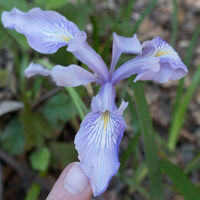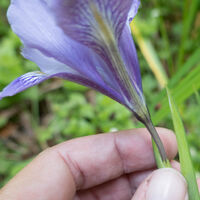douglas iris
Iris douglasiana
Member of
irises (genus Iris)
iris family (family Iridaceae)
monocots (class Liliopsida)
purple, pale purple in flowering plants



- perianth light to dark lavender, deep red-purple, or pale cream, veined purple
- perianth tube 10–24 mm, funnel-shaped
- stem generally branched, 15–50 cm
- basal leaves 10–22 mm wide
- bifacial, i.e. one side shiny, the other side dull
- 1–3 cauline leaves, similar to basal
- sepals 5–8 cm, 14–30 mm wide, obovate
- petals 5–7 cm, 10–18 mm wide, obovate
- ovary triangular, with nipple-like projection at tip
- style branches 30–50 mm, crests 9–20 mm, stigmas triangular
- var. major has a cross of characteristics between fernald’s iris (Iris fernaldii) and douglas iris (Iris douglasiana) [source]
Toxicity of flag, iris, snake lily (Iris spp.):
1 – Skin contact with these plants can cause symptoms ranging from redness, itching, and rash to painful blisters like skin burns.
3 – Ingestion of these plants is expected to cause nausea, vomiting, diarrhea and other symptoms that may cause illness but is not life-threatening.
Locations: Months: For more details, use advanced search.
Chris’s observations: 14 (8 are research grade)
Taxon info: iNaturalist – Calflora – CalPhotos – Jepson eFlora – FNA
Bay Area species: iNaturalist – Calflora